Wuyi Oolong Tea
Unraveling the Authentic Source
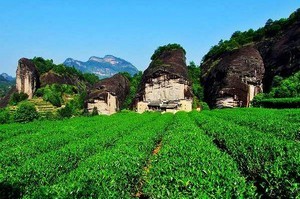 Whether I am in China or the West, speaking about Wuyi is likely to be a conversation stopper. People know it is a tourist attraction, not they won't know much about the tea.
Whether I am in China or the West, speaking about Wuyi is likely to be a conversation stopper. People know it is a tourist attraction, not they won't know much about the tea.
If you are a tea lover, it is difficult not to get excited about it. Here are some amazing facts about the mountain and tea:
-
The Mountain is regarded as the richest depository of tea varieties in the world. Wuyi tea plants even have their own name - Var Bohea.
-
A Unesco heritage site since 1999, the mountain is renown for its biodiversity.
-
Despite the biodiversity, the Mountain is small - it is just a mere 60 kilometer square. Can you imagine how precious an authentic Wuyi tea is?
It has a thousand year history as a Tribute tea.
-
It is home to the most precious tea plant in China: the 600 year-old Dahongpao.
-
According to William Ukers, who wrote All About Tea in 1935, Wuyi oolong tea was one of the first teas to be exported to Europe in the early 17th century.
Biologists have been busy conducting field research there since 1873. They have identified nearly 4,000 plant species and 5,000 animal species.
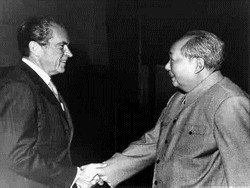
In China, the best teas were reserved for the emperor; they are known as the Tribute tea.
Famous Song dynasty's poets Fan Zhongyan and Su Shi both alluded to Wuyi's fame. It gained the tribute status as early as in the 11th century.
When President Nixon visited, Chairman Mao presented him with 100 grams of tea leaves. When Nixon alluded to Mao's "stinginess", Premier Zhou explained such tiny quantity is worth half of Chinese Empire.
Geographical Wonder
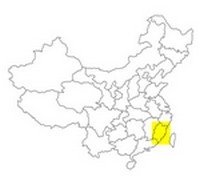 Wuyi Mountain is a geographical wonder. It has everything the world has to offer: spectacular scenery, flowing water and rich volcanic soils.
Wuyi Mountain is a geographical wonder. It has everything the world has to offer: spectacular scenery, flowing water and rich volcanic soils.
Situated in the Fujian Province of Southeastern China, the mountain has an average elevation of 650 metes above sea level ranging from from 200 to 2200 meters.
It is a gigantic volcanic fault structure characterized by meandering river valleys flanked by dome-shaped, vertical cliffs (the crags), deep gorges, cave systems and flat plain.
It is famous for its 36 peaks and 99 crags, with tea being cultivated in each crag. The nine-bend river (Jiuqu Xi) meanders in a deep gorge among these hills.
This is a tea paradise with the greatest density of tea species ever found on Planet Earth.
It was said that one crag (Huiwan Yan) has as many as 830 named tea species. Imagine there are 99 famous crags in the whole of Wuyi Mountain. How many tea species are there in total?
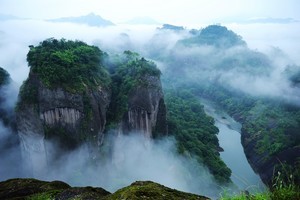 In China it is known as the Yancha, meaning Crag Tea. In the West it is known as the Rock Tea.
In China it is known as the Yancha, meaning Crag Tea. In the West it is known as the Rock Tea.
It is not a single tea and refers collectively to the teas grown in Wuyi.
Some Western vendors sell Wuyi green tea, which is unheard of in China. Wuyi Mountain is renowned for producing oolong tea, not green tea.
Wuyi oolong tea is one of China's Ten Famous Teas.
While quality green tea tastes light and clean, Wuyi is the polar opposite. It is heavily oxidized (like black tea) and (unlike black tea) it is roasted, and frequently heavily roasted, which lends fire and a slight bitterness to the taste.
The highest grade tea grows on the volcanic ashes of high mineral content, which explains the unique yanyun or rock flavors. In China, it is described as "crag bone floral fragrance".
Crag bone refers to the high mineral content. Floral fragrance refers to the highly aromatic nature of this semi-oxidized oolong tea. It is a irresistible combination. The after-feeling is long lasting and excellent.
Rich in potassium, manganese and other trace minerals, Wuyi is the perfect winter drink, a great tonic and perfect complement to green tea.
Unlike the Tieguanyin oolong which is tightly rolled into ball-shaped, Wuyi oolong is long and curly and fragile as they have been heavily roasted.
When A Famous Tea Turns Into Myth
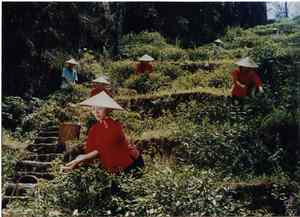 Those who have studied the history of Famous Teas would have noticed a familiar pattern, a pattern that tea sellers would loath to admit. The difficulty arises because the concepts of "rare" and "famous" don't co-exist.
Those who have studied the history of Famous Teas would have noticed a familiar pattern, a pattern that tea sellers would loath to admit. The difficulty arises because the concepts of "rare" and "famous" don't co-exist.
Famous Teas became famous because they were crafted from rarely available plant materials, but once a tea becomes famous, there is insufficient supply to meet the explosive demands.
They are then sourced from second or even third rate regions surrounding the Authentic Source.
This is okay, not everyone cares about authenticity.
The problem arises when legend turns into myth. "What's so great about this Famous Tea? Where can I find the real thing?", we wonder.
Yes, the real thing is what we want.
We want to connect to the spark that inspires the genius of the original inventor. We want to understand and experience what makes this Famous Tea great.
We want to know the true location of the authentic source. We want the authentic taste in our mouths and noses - even if it is only in the smallest quantity in one unforgettable day.
The one day and occasion that we will remember for the rest of our lives.
In short, we don't want to be sold short, and we want to unravel the mystery of the Authentic Source.
Where Is The Authentic Source?
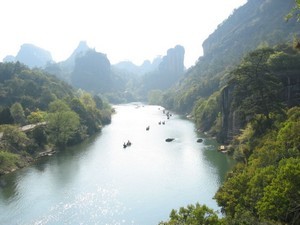 Only a small part of Wuyi Mountain is craggy. Zoom into the rocky parts of the Mountain if you want to taste yanyun!
Only a small part of Wuyi Mountain is craggy. Zoom into the rocky parts of the Mountain if you want to taste yanyun!
Wuyi tea is graded according to where it is grown. From ascending order of quality:
Outside the Mountain
The Mountain has an area of only 64 kilometers square. Many so-called Wuyi teas are grown outside the Mountain. They are moderately priced and are usually certified organic.
Flat Plain (Zhoucha)
This refers to teas growing beside the River in the flat plain rather than in the craggy valleys. They cannot be considered Rock tea as they don't grow out of volcanic ashes.Small Rock (Banyan Cha)
Known as the Half Rock or the Small Rock, they grow at the border of the rocky areas. Yanyun exists but is substantially weaker.Big Rock (Zhengyan Cha)
The authentic source of Wuyi tea is the Big Rock, which consists of Three Valleys and Two Ravines. These five craggy valleys are the crown jewels of the Mountain.
Just one Rock alone (Huiwan Yan) is said to have 830 different types of tea plants. These Five Rocks are the source of Wuyi's biodiversity.
Together they produce 10 tonnes of tea each year. Most go to the local government and senior government officials in China.
Only a tiny quantity trickles down to lay people like us. They are rare and highly sought after but is currently available in the tea shop as a 7-in-1 Sampler.
Also In This Section...
Wuyi Oolong Tea - How It Is Made
Harvesting and making process explained.
Wuyi Rock Tea - Introducing the Tea Plants
Understanding the various Wuyi Rock tea plants.
New! Comments: Like This Story? Leave A Comment!
References
Chen Zhong Xian (1992). Zhongguo Chajing. Shanghai Wenhua Chubanshe.
Photos are kindly provided by the Wuyi Mountain Government Unit.
Back to Top of Wuyi Oolong Tea
Back to Wuyi Tea Main Page
Back to Tea Shop Main Page
